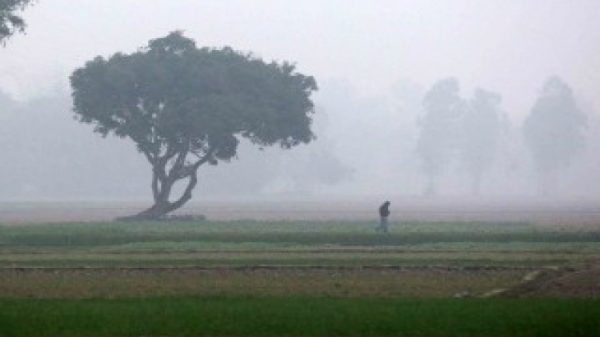Changes in winter patterns threaten crop yields

Shawdesh Desk:
Winter is shrinking but becoming more intense during its short stay in Bangladesh, turning the season’s crop calendar upside down.
The shrinking of winter implies the expansion of warmer days, threatening to disrupt winter crop production.
The agrarian economy of heavily populated Bangladesh has vast swathes of land producing four crops a year.
The warming of winter also resulted in an evident increase in outbreaks of diseases, adding yet another reason for winter crop yield loss.
‘Seasonal crops have a tolerance capacity beyond which their productions drop,’ AKM Ruhul Amin, who teaches agronomy at Sher-e-Bangla Agricultural University, told New Age.
An analysis of historic winter data preserved by the Bangladesh Meteorological Department showed that the number of cold days in December and February, the first and last months, respectively, of the three-month-long winter season, reduced, both in terms of frequency and intensity.
On the other hand, cold days in January, the coldest winter month, increased both in frequency and intensity, according to BMD data recorded between 1981 and 2023.
Cold days are days with a minimum temperature of 10C or below. They are categorised into three classes- mild, moderate, and severe.
The number of mild cold days, when the minimum temperature stayed between 10C and 8C, in Januaries increased over four decades since 1981, with 1,664 such cold days recorded in the latest decade of 2011–2020.
In the decade 2001–2010, 1,506 mild cold days were recorded in Januaries while 1,681 such cold days were recorded in the decade before that and 1,214 cold days were recorded in the decade 1981-1990.
Moderate cold days with a minimum temperature between 8C and 6C also increased in Januaries over the same period of time, with 522 such cold days recorded in 2011–2020, up from 356 such cold days recorded in the decade before.
There were 580 moderate cold days recorded in the decade 1991-2000 and 295 moderate cold days between 1981 and 1990.
The number of severe cold days with a minimum temperature between 6C and 4C, in Januaries rose to 111 days between 2011 and 2020, the highest number of such days recorded in a decade since 1981.
There were 60 severe cold days in the decade of 2001–2010, following 87 severe cold days recorded in the decade before and 32 severe cold days recorded in the decade before that.
The number of severe cold days, on the other hand, was reduced to just two over the 2011–2020 period in Februaries, following five such days recorded in the previous decade and 10 such days recorded in 1981–1990.
Februaries in the decade 1991-2000 saw no severe cold days.
Moderate cold day numbers were also on the decline in Februaries with 40 such days recorded between 2011 and 2022, down from 54 such days recorded in the decade of 1981–1990.
The number of mild cold days, however, has remained more or less the same in Februaries since 1981.
In a report released in the past month, the BMD said that the number of cold outbreaks in December and February reduced, producing division-wise data between 1980 and 2020.
There were no cold outbreaks in December in the decade 2011–2020, while one cold outbreak was recorded between 2001 and 2010 in the Dhaka division. Two cold outbreaks were recorded in the decade between 1991 and 2000 and three outbreaks in the previous decade.
In Rajshahi, the BMD report titled ‘Changing Climate of Bangladesh’ pointed out, cold outbreaks started in the first week of December until 2006, but then delayed and decreased.
The number of cold outbreaks in February also decreased in the Rajshahi division.
Cold outbreaks became fewer at the end of February in the Rangpur division, where winter started later than it used to be over the past few years, not beginning until the third or last week of December.
In Khulna, Barishal, Chattogram, Sylhet, and Mymensingh divisions, cold waves became less frequent in December and almost non-existent in February, the BMD report revealed.
Winter losing its character has a huge impacts on many crops cultivated during the season, especially rice cultivation.
Winter is the season when boro seedbeds are grown and seedlings are planted in the field.
Intense cold in January this year, accompanied by foggy days, destroyed seedbeds in many areas, prompting more pesticide use.
Many farmers could not save the day. Many farmers either had to reduce their boro cultivation area or spend way more than they thought on buying boro seedlings from the market.
Boro is Bangladesh’s most important crop, accounting for over half of the staple rice’s consumption.
Bangladesh Agricultural Research Institute chief scientific officer Abul Khayer Miah said that a shrinking winter would contribute in many ways to reducing crop yields.
‘The change could also mean lifting more groundwater,’ he said.
One of the worst impacts of the warming winter has been outbreaks of multiple diseases that were otherwise nonexistent even a decade ago.
Bangladesh Wheat and Maize Research Institute senior scientific officer Mohammad Mobarak Hossain said that the cultivation of maize was threatened by breakouts of attack from fall armyworm.
‘Warmer winter days are favourable for fall armyworm attacks,’ he said.
Maize has become an important winter crop lately because of its growing demand, particularly in the poultry sector. The maize cultivation area expanded from 1.28 lakh hectares in 2009 to 4.12 million hectares in 2021.
Agronomists fear the recurrence of losses from fall armyworm attacks could push farmers off maize cultivation, increasing the country’s import dependency.
Panama disease, caused by a soil-borne fungus, has hit banana cultivation in northern Bangladesh, with reports of the disease wiping out banana plantations in an entire union of Ishwardi upazila in Pabna.
The Panama disease became a threat to winter crops, particularly when the temperature reached between 20 and 30C.
First detected in 1876, Panama disease was not viewed as a significant threat to crop cultivation until the disease heavily affected banana plantations in the early 20th century, with temperatures rising.
Department of Agricultural Extension officers advised farmers to switch to other crops in case of Panama disease outbreaks, implying an imminent fall in banana production in areas where the disease emerged.
Panama disease could affect the cultivation of the affected crop for several years.
The cultivation of wheat is also being affected by blast disease with the temperature rising in winter, said the wheat research centre.
Despite an increase in yield capacity, the production of wheat fell from 1.91 million tonnes in 1999 to 1.09 million tonnes in 2021, with its cultivation area dropping by a third.
The production of sugarcane also decreased from 7.68 million tonnes in 1991 to 3.33 million tonnes in 2021, as its cultivation was reduced by a third, according to data provided by Our World in Data.
The production of pulses and sweet potatoes also decreased significantly.























Leave a Reply